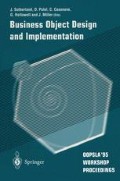Abstract
Applying object orientation to the task of modeling the value-added processes of a business enterprise is a task that should be examined both conceptually and practically. This paper does both, but its main theme is a conceptual reliance on a standardized object template — the REA (resource-event-agent) model — at various levels of abstraction as that template is used to model the economic activities of an enterprise. Deployment of REA concepts in business object design and implementation is a semantic strategy for increasing reusability and interoperability. We explain the components and use of REA models in the context of a simple example, and we discuss also its predictable patterns of implementation compromise. The paper finishes with a discussion of the adaptation of various object-oriented analysis and design techniques to the task of REA modeling of enterprises.
Access this chapter
Tax calculation will be finalised at checkout
Purchases are for personal use only
Preview
Unable to display preview. Download preview PDF.
References
Andros, D.P., J.O. Cherrington, and E.L. Denna. 1992. Reengineer your accounting the IBM way. Financial Executive. July/August. 28–31.
Booch, G. 1994. Object-oriented analysis and design. Benjamin Cummings, Redwood City, CA.
Burch, J. G. 1994. Cost and management accounting: A modern approach. West Publishing, St. Paul, MN.
Chen, P.P. 1976. The entity-relationship model - toward a unified view of data. ACM Transactions on Database Systems. March. 9–36.
Cherrington, J.O., W.E. McCarthy, D.P. Andros, R. Roth, and E.L. Denna. 1993. Event-driven business solutions: implementation experiences and issues. Proceedings of the Fourteenth International Conference on Information Systems. Orlando. 394.
Coad, P. (with D. North and M. Mayfield). 1995. Object models: Strategies, patterns, & applications. Prentice-Hall, Englewood Cliffs, NJ.
David, J.S. 1995. An empirical analysis of REA accounting systems, productivity, and perceptions of competitive advantage. Doctoral dissertation. Michigan State University.
Dunn, C.L. and W.E. McCarthy. 1992. Conceptual models of economic exchange phenomena: History’s third wave of accounting systems. Collected Papers of the Sixth World Congress of Accounting Historians. Kyoto, Japan. Volume I. 133–164.
Elliott, R.K. 1992. The third wave breaks on the shores of accounting. Accounting Horizons. 1–21.
Fisher, J.S. 1994. What’s ahead in accounting: The new finance. Journal of Accountancy. August. 73–76.
Gal, G. and W.E. McCarthy. 1986. Operation of a relational accounting system. Advances in Accounting. v.3. 83–112.
Gamma, E., R. Helm, R. Johnson, and J. Vlissides. 1995. Design patterns: Elements of reusable object-oriented software. Addison-Wesley, Reading, MA.
Geerts, G. 1993. Toward a new paradigm in structuring and processing accounting data. Doctoral dissertation. Free University Brussels.
Geerts, G. 1995. The semantic modeling of accounting phenomena, Working paper, Michigan State University.
Geerts, G. and W.E. McCarthy. 1992a. The extended use of intentional reasoning and epistemologically adequate representations in knowledge-based accounting systems. Proceedings of the Twelfth International Workshop on Expert Systems and Their Applications. Avignon, France. EC2: 321–32.
Geerts, G. and W.E. McCarthy. 1992b. Database accounting systems. IT and accounting: The impact of information technology. B.C. Williams and B.J. Spaul (eds.). Chapman & Hall. 159–183.
Geerts, G. and W.E. McCarthy. 1992c. The cost revolution from a data modeling point of view. Paper presented to the Congress of the European Accounting Association, Madrid, Spain. April.
Geerts. G. and W.E. McCarthy. 1994. The economic and strategic structure of REA accounting systems. Paper presented to the 300th anniversary program, Martin Luther University, Halle-Wittenberg, Germany. September.
Geerts. G. and W.E. McCarthy. 1995. Augmented intensional reasoning in knowledge-based accounting systems. Paper submitted to Journal of Information Systems.
Geijsbeek, J. B. 1914. Ancient double-entry bookkeeping. Scholars Book Co., Houston.
Grabskd, S.V. and RJ. Marsh. Forthcoming. Integrating accounting and advanced manufacturing information systems: An ABC and REA approach. Journal of Information Systems.
Hollander, A. S., E. L. Denna, and J. O. Cherrington. 1995. Accounting, information technology, and business solutions. Richard D. Irwin, Chicago, IL.
Jacobson, I. 1992. Object-oriented software engineering: A use case driven approach. Addison-Wesley. Reading, MA.
Jacobson, I., M. Jacobson, and A. Jacobson. 1995. The object advantage: Business process reengineering with object technology. ACM Press. New York.
McCarthy, W.E. 1979. An entity-relationship view of accounting models. The Accounting Review. October. 667–86.
McCarthy, W.E. 1980. Construction and use of integrated accounting systems with entity-relationship modeling, in P. Chen, ed. Entity-Relationship Approach to Systems Analysis and Design. North-Holland. 625–37.
McCarthy, W.E. 1982. The REA accounting model: A generalized framework for accounting systems in a shared data environment. The Accounting Review. July. 554–578.
McCarthy, W.E. 1984. Materialization of account balances in the REA accounting model. Paper presented to the annual meeting of the British Accounting Association. Norwich, England. April.
McCarthy, W. E. 1987. On the future of knowledge-based accounting systems. The D.R. Scott Memorial Lecture Series. The University of Missouri. 19–42.
McCarthy, W. E. 1995. The evolution of accounting systems. Paper presented at Erasmus University, Rotterdam, The Netherlands. September.
McCarthy, W. E. and S.Rockwell. 1989. The integrated use of first-order theories, reconstructive expertise, and implementation heuristics in an accounting information system design tool. Proceedings of the Ninth International Workshop on Expert Systems and Their Applications. Avignon, France. EC2: 537–548.
Porter, M.E. 1985. Competitive advantage. The Free Press, N.Y.
Semich, J. W. 1995. CIS manufacturing: Build, buy, or reengineer? Datamation. September.
Smith, J.M. and D.C.P. Smith. 1977. Database abstractions: Aggregation and generalization. ACM Transactions on Database Systems. June. 105–133.
Winsberg, P. 1995. Legacy code: Don’t bag it, wrap it. Datamation. May.
Author information
Authors and Affiliations
Editor information
Editors and Affiliations
Rights and permissions
Copyright information
© 1997 Springer-Verlag London Limited
About this paper
Cite this paper
Geerts, G.L., McCarthy, W.E. (1997). Modeling Business Enterprises as Value-Added Process Hierarchies with Resource-Event-Agent Object Templates. In: Sutherland, J., Casanave, C., Miller, J., Patel, P., Hollowell, G. (eds) Business Object Design and Implementation. Springer, London. https://doi.org/10.1007/978-1-4471-0947-1_10
Download citation
DOI: https://doi.org/10.1007/978-1-4471-0947-1_10
Publisher Name: Springer, London
Print ISBN: 978-3-540-76096-2
Online ISBN: 978-1-4471-0947-1
eBook Packages: Springer Book Archive

